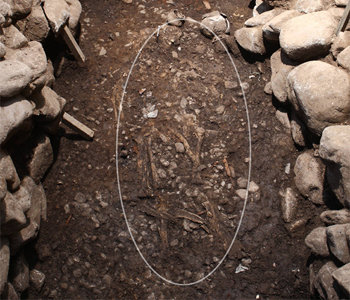Man buried alive with Shilla noblewoman found in Gyeongju
Man buried alive with Shilla noblewoman found in Gyeongju
Posted April. 10, 2015 07:18,

A man in his 20s who buried alive with a noblewoman of the Shilla Dynasty has been found. This was the first time to discover a grave where a young man was buried together with his female master.
The Cultural Heritage Administration said on Thursday, The Foundation of Shilla Cultural Heritage Research has excavated the remains of a man and a woman assumed to be in their 20s or 30s along with several relics of the Shilla Dynasty, such as accessories and harness. The tomb was dolmujideotneol grave (a grave in which a buried body covered by boards and then by stone mound) and a similar-sized tomb is located right next to it."
The excavation team explained that a buried person who was lying on the back has thin thigh bones and shows anatomical features of female such as backbones of earflap in the skull. From muscle lines of leg bones, and the size and wearing of teeth, the body is presumed to be a woman in her 30s with well-developed muscle. The remains was wearing golden earrings and a belt embroidered with gold.
Given the fact that a golden crown was not discovered, and the tombs size and relics fall short of those found in royal tombs, this woman seems to have been a noble lady. Some reckon that she must have been a woman from a highest social class as the tomb was closely located with Cheomseongdae, an observatory tower constructed during the Shilla Dynasty, and Hwangnamdaechong, a grave that is assumed to be a royal tomb.
Another remain that is lying on the side facing the female body is presumed to be a man in his 20s given the lines of soleus muscle in calf bone, thickness of thigh bones and teeth. The remains were lying tilted without wearing any relics, based on which it is assumed to be someone buried alive.
Kim Gwon-il, excavation team chief of the Foundation of Shilla Cultural Heritage Research, said, In general, men to be buried alive were children or old people aged over 50. It is unprecedented to find a young man in his 20s buried with a female in a main coffin of a tomb. The custom of burying someone alive has been found in tombs from the dynasties of Goguryeo, Baekje, Shilla and Gaya.
What is interesting is that teeth of the man was placed near the right shoulder of the woman and his leg bones was obliquely overlapped from the right to the left side of the womans body. Some contend that the two were buried in the position of having sexual intercourse but the excavation team denied the contention.
Golden earrings and silver belt were also dug up along with a necklace made with green jades and blue beads. The silver belt consists of a band hook and some 30 accessories with detailed pattern of a dragon on the hook.
The tomb was found while a detached-house was re-built. Some 24 tombs from the Shilla Dynasty were discovered including four "um" grave (a general grave where a body is buried without special underground sections or accessories), 11 "deotneol" grave (a grave in which a buried body covered by boards), seven "dolmujideotneol" grave and a "dok" grave (a grave of big pot in which a body is buried). As deotneol grave from the early Shilla Dynasty has rarely been excavated, the recent discovery has high academic values, said sources from the Cultural Heritage Administration.
sukim@donga.com







